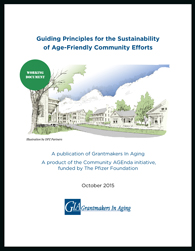How To Develop Age-Friendly Efforts That Last
5 principles help support ongoing success

Jeff Cadge/Getty Images
A multi-generational family on a porch. Grantmakers in Aging (GIA), a nonprofit comprised of philanthropies dedicated to improving the experience of aging, conducted a study to understand what principles would contribute to sustainable age-friendly efforts. Communities throughout the country are undertaking work to become more age-friendly by improving the quality of life of all residents, especially older adults.
Communities throughout the country are undertaking work to become more age-friendly by improving the quality of life of all residents, especially older adults.
The reason for this is an increasing awareness by both national and local leaders that the overall U.S. population is skewing older, that people are living longer and that the vast majority of older adults do not want to move from their homes or communities as they age.
Subscribe! AARP Livable Communities eNewsletter
Since its creation in 2012, the AARP Network of Age Friendly Communities has attracted dozens of U.S. towns, cities and counties to its ranks. That means the elected leadership of each community (check out the current Member List) has made a commitment to assess the community-based needs of its older population, create a plan for meeting them and then implement the work to do just that.
Similar work is being done in countries around the globe. Communities that aren't in the AARP network — or in the World Health Organization Global Network of Age-friendly Cities and Communities — are undertaking similar efforts. All involved in age-friendly efforts want to both accelerate the effort and ensure its sustainability.
Grantmakers in Aging (GIA), a nonprofit comprised of philanthropies dedicated to improving the experience of aging, conducted a study to understand what principles would contribute to sustainable age-friendly efforts. Beyond simply funding an effort, these principles outline five key characteristics that, when incorporated into age-friendly efforts, provide a primer for local action. The guiding principles, which are addressed in detail by the report, "Guiding Principles for the Sustainability of Age-Friendly Community Efforts," are as follows:
1. Build Public Will
- Identify and develop potential champions
- Foster citizen commitment
- Address misconceptions of aging and older adulthood
- Use early wins to demonstrate age-friendly benefits
- Communicate broadly
- Celebrate accomplishments
2. Engage Across Sectors
- Connect with a variety of sectors
- Engage with initiatives that benefit a wide range of ages and constituencies
- Engage regional planning organizations
- Embed age-friendly efforts in established organizations and programs
- Be deliberately inclusive
3. Utilize Metrics
- Develop meaningful community metrics that contribute to building a local, compelling case for age-friendly work
- Measure the performance of age-friendly work
4. Secure Resources
- Identify a backbone organization to drive age-friendly efforts
- Leverage partnerships for noncash resources
- Seek diverse funding sources for start-ups and demonstration projects
5. Advance Age-Friendly Public Policies, Practice and FundingBe alert to sustainable funding streams
- Embed age-friendly goals and strategies into municipal, regional, state and federal planning documents
- Work with municipal, regional, state, and federal governments to adopt policies and practices that make communities and regions good places for people of all ages
Throughout these principles — and important to all age-friendly work — is recognizing the need to dispel negative views about older adults.
Strategies for supporting the five principles are detailed in the report, as are examples of how communities have incorporated each of these principles in their age-friendly efforts.
About sustainability, GIA says: "Sustaining age-friendly efforts requires much more than financial support. It includes establishing enduring and productive partnerships, encouraging existing organizations to incorporate age-friendly activities into their core missions and providing hard data and evaluation findings to document the benefits of age-friendly communities. Sustainability also includes engaging a variety of audiences and constituencies in planning and implementation, and ultimately securing long-term sources of nonfinancial, as well as financial, support."
How to Use
The framework, and its principles and related strategies, will be helpful to a wide range of community leaders, elected officials, organizations and residents interested in creating age-friendly communities. As GIA writes, "both those who are only now embarking on this journey as well as those who are more experienced should find the concepts helpful."
As AARP and the other organizations that contributed to the GIA working document (see the box at top) know, age-friendly work is a process that requires taking the long view and having a community commitment. When that happens, the return to residents of all ages is substantial.
Jeanne Anthony, a project advisor for AARP Livable Communities, manages the AARP Network of Age-Friendly Communities program. She served on the Grantmakers in Aging committee that created the "Guiding Principles for the Sustainability of Age-Friendly Community Efforts" report.
Age-Friendly Communities Tool Kit Resources
Joining
- The Member List
See the current roster of enrolled communities in the United States as well as their action plans and other information
- Preparing the Membership Materials
Find the membership application, sample letters of commitment, resolutions and more
Learning
- AARP Network of Age-Friendly Communities Program Cycle
Download a visual overview of the program’s steps and elements
- AARP Age-Friendly Resource Guide
A selection of key resources to support age-friendly communities through all stages of the program cycle
- World Health Organization Guide to Age-Friendly Cities
Download this 82-page guide for a deep dive into the program
- Better Together: A Comparative Analysis of Age-Friendly and Dementia Friendly Communities
Read an AARP report and find links to related resources
Funding
- Age-Friendly Foundations
These funding organizations are helping make communities more livable
Evaluating
- Evaluating Your Age-Friendly Community Program: A Step-by-Step Guide
Use this resource when you're identifying indicators in your action plan
Sustaining
- Guiding Principles for the Sustainability of Age-Friendly Community Efforts
Learn how to maintain ongoing success
Stay Informed — For Free!
AARP.org/Livable
Enter a topic, name, place, etc.





